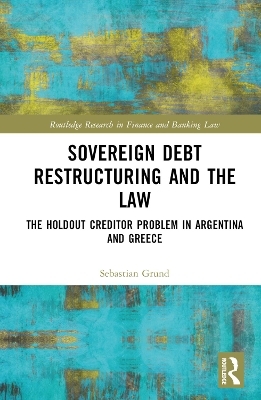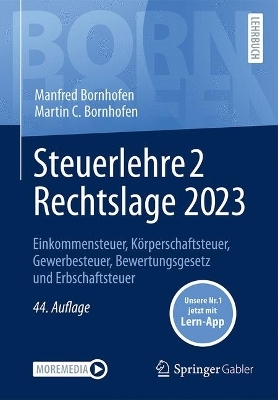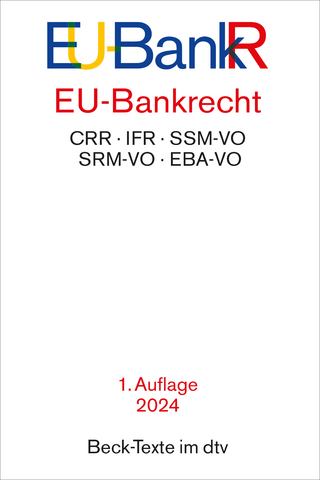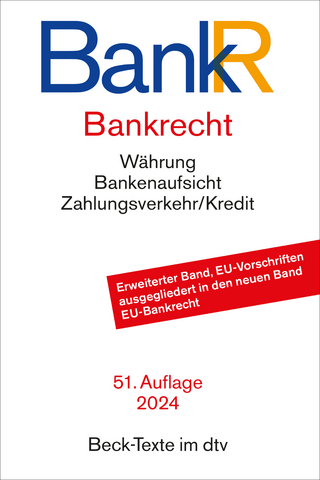
Sovereign Debt Restructuring and the Law
Routledge (Verlag)
978-0-367-77460-8 (ISBN)
Following an introduction to sovereign debt and its restructuring, the book provides the first comprehensive analysis of the holdout creditor problem in the context of the two largest sovereign debt restructuring operations in history: the Argentine restructurings of 2005 and 2010 and the 2012 Greek private sector involvement. By reviewing numerous lawsuits and arbitral proceedings initiated against Argentina and Greece across a dozen different jurisdictions, it distils the organizing principles for ongoing and future cases of sovereign debt restructuring and litigation. It highlights the different approaches judges and arbitrators have adopted when dealing with holdout creditors, ranging from the denial of their contractual right to repayment on human rights grounds to leveraging the international financial infrastructure to coerce governments into meeting holdouts’ demands. To this end, it zooms in on the role the governing law plays in sovereign debt restructurings, revisits the contemporary view on sovereign immunity from suit and enforcement in the international debt context, and examines how creditor rights are balanced with the sovereign’s interest in achieving debt sustainability. Finally, it advances a new genealogy of holdouts, distinguishing between official and private sector holdouts and discussing how the proliferation of new types of uncooperative creditors may affect the sovereign debt architecture going forward.
While the book is aimed at practitioners and scholars dealing with sovereign debt and its restructuring, it should also provide the general reader with the understanding of the key legal issues facing countries in debt distress. Moreover, by weaving economic, financial, and political considerations into its analysis of holdout creditor litigation and arbitration, the book also speaks to policymakers without a legal background engaged in the field of international finance and economics.
Sebastian Grund is a Legal Counsel at the International Monetary Fund (IMF) and previously worked at the European Central Bank (ECB) as a lawyer and economist. He holds a PhD in law from the University of Vienna and an LLM from Harvard Law School. He’s a member of the New York bar. This book was written before his employment with the IMF, and the views expressed herein are those of the author and do not necessarily represent the views of the IMF, its Executive Board, or IMF management.
Preface
Acknowledgements
Acronyms, Abbreviations, and Defined Terms
1 Sovereign Debt and Its Restructuring
1.1. Sovereign Debt – An Overview
1.2. Sovereign Debt Restructuring
1.2.1. Introduction
1.2.2. Definition and Types of Sovereign Debt Restructurings
1.2.3. Legal and Transactional Aspects of Sovereign Debt Restructurings
1.2.3.1. Restructuring Principles and Processes
1.2.3.2. Debt Restructuring Methods
1.2.3.2.1. Debt Restructuring Versus Debt Rescheduling
1.2.3.2.2. Debt Restructuring Techniques: Sticks and Carrots
1.2.3.3. Scope of Debt Restructurings
1.2.3.3.1. Domestic Versus Foreign Sovereign Debt Restructurings
1.2.3.3.2. Creditor Classes, Ranking, and Priority
1.2.4. Holdout Creditor Problems in Sovereign Debt Restructurings
1.2.5. The Evolution of Sovereign Debt Restructuring Practice
2 Holdout Creditor Problems and Foreign Law Debt: The Argentine Debt Restructurings in Courts and Tribunals (2001–2016)
2.1. Argentina’s Sovereign Debt Restructurings (2001–010)
2.1.1. Background
2.1.2. The 2005 Debt Restructuring
2.1.3. The 2010 Debt Restructuring
2.2. Holdout Litigation After Argentina
2.2.1. Holdout Litigation in Foreign Domestic Courts
2.2.1.1. United States
2.2.1.1.1. Lightwater v Argentina
2.2.1.1.2. EM v Banco Central de la Repúlica Argentina
2.2.1.1.3. NML Capital v Argentina
2.2.1.2. Germany
2.2.1.2.1. BVerfG Decision of 8 May 2007
2.2.1.2.2. BGH Decision of 25 November 2010
2.2.1.2.3. BGH Decision of 24 February 2015
2.2.1.2.4. BVerfG Decision of 3 July 2019
2.2.1.3. Italy
2.2.1.3.1. Italian Supreme Court (Corte Suprema di Cassazione)
2.2.1.4. United Kingdom
2.2.1.4.1. UK Supreme Court
2.2.1.5. France
2.2.1.5.1. French Supreme Court (Cour de Cassation)
2.2.1.6. Switzerland
2.2.1.6.1. Swiss Federal Supreme Court
2.2.2. Holdout Litigation in International Courts and Tribunals
2.2.2.1. International Tribunal for the Law of the Sea
2.2.2.2. International Court of Justice
2.2.3. Interim Conclusions: Enforcing Sovereign Debt in Foreign Courts
2.2.3.1. Adjudicatory Sovereign Immunity
2.2.3.1.1. The Commercial Activity Exception: ‘Once A Trader Always A Trader’ and the Mixed Activity Conundrum
2.2.3.1.2. Recognition of Foreign Judgements
2.2.3.2. Immunity from Enforcement
2.2.3.2.1. The Immunity of Public Claims from Creditor Attachment
2.2.3.2.2. The Immunity of Central Bank Reserves from Attachment
2.2.3.2.3. ARA Libertad and the Immunity of (Military) Vessels
2.2.3.3. Third-Party Injunctions: A New Super Remedy to Circumvent the Immunity Defence?
2.3. Holdout Arbitration After Argentina
2.3.1. International Investment Arbitration Before ICSID Tribunals
2.3.1.1. Abaclat and Others v Argentine Republic
2.3.1.1.1. Sovereign Bonds as Investment
2.3.1.1.2. Jurisdiction over Mass Claims
2.3.1.1.3. The Dissenting Opinion by Professor Abi-Saab
2.3.1.2. Ambiente Ufficio v Argentine Republic
2.3.2. Interim Conclusions
2.3.2.1. Sovereign Bond Arbitration Against Argentina –Producing a Monster?
2.3.2.2. ICSID Jurisdiction and the Rejection of the Salini Test
2.3.2.2.1. Contribution to the Development of the Host State
2.3.2.2.2. Duration
2.3.2.2.3. Risk-Sharing
2.3.2.2.4. Territorial Link
2.3.2.2.5. The Admissibility of Mass
Claims
2.4. Settling a Decade of Holdout Lawsuits Against Argentina
2.4.1. The 2016 Election and Argentina’s Return to International Financial Markets
2.4.2. Settling with the Vulture Holdouts
2.4.3. Settling with the Retail Holdouts
3 Holdout Creditor Problems and Domestic Law Debt: The Greek Debt Restructuring in Courts and Tribunals (2012–2020)
3.1. Introduction
3.2. The Greek Sovereign Debt Crisis: 2009–2015
3.3. The Greek Debt Restructuring of 2012
3.3.1. Debt Restructuring Negotiations: The Role of the Troika and the IIF
3.3.2. Restructuring Greek Law Bonds
3.3.3. Restructuring Foreign Law Bonds
3.4. Holdout Creditor Litigation After Greece in Foreign Courts
3.4.1. Germany
3.4.1.1. BGH Judgment of 8 March 2016
3.4.1.2. BGH Judgment of 19 December 2017
3.4.1.3. BVerfG Judgment of 6 May 2020
3.4.2. Austria
3.4.2.1. OGH Judgment of 20 May 2014
3.4.2.2. OGH Judgment of 27 January 2016
3.4.2.3. OGH Judgements of 25 April 2017 and 22 January 2019
3.4.2.4. OGH Judgment of 21 February 2020
3.4.3. Interim Conclusions
3.4.3.1. Sovereign Immunity in Domestic Law Restructurings
3.4.3.2. (Some) Hypothetical Problems with Enforcing Greek Sovereign Debt in Germany and Austria
3.5. Holdout Litigation After Greece in European Courts
3.5.1. Court of Justice of the EU (CJEU)
3.5.1.1. Accorinti v ECB
3.5.1.2. Fahnenbrock v Hellenic Republic
3.5.1.3. Hellenic Republic v Kuhn
3.5.2. European Court of Human Rights (ECtHR)
3.5.2.1. Mamatas v Greece
3.5.3. Interim Conclusions
3.5.3.1. Sovereign Debt Restructurings in European Courts: Novel Judicial Challenges
3.5.3.2. The (Tenuous) Link Between Sovereign Immunity and Jurisdiction Under EU Law
3.5.3.3. Jurisdiction Under the Brussels I Regulation
3.5.3.4. Property Right Guarantees for Sovereign Bondholders in Unilateral European Sovereign Bond Restructurings
3.5.3.5. The (Preferential) Treatment of Eurosystem Claims in Euro Area Sovereign Debt Restructurings
3.6. Holdout Arbitration After Greece
3.6.1. Poštová banka v Hellenic Republic
3.6.2. Interim Conclusions: Closing Pandora’s Box?
4 Holdouts in Foreign Versus Domestic Law Debt Restructurings: Walking Back from Argentina and Greece
4.1. Introduction
4.2. The Role of Governing Law in Sovereign Debt Restructurings
4.3. The Legal Basis for Sovereign Debt Instruments: Contracts Versus Statutes
4.4. Sovereign Immunity Revisited
4.5. The Protection of Sovereign Creditors’ Property Rights
5 A Genealogy of Holdout Creditors: The Future of Sovereign Debt Restructuring
5.1. The Proliferation of Holdout Creditors
5.2. Private Sector Holdouts
5.2.1. Vulture Funds
5.2.2. Banks
5.2.3. Asset Management Funds (Real Money Investors)
5.2.4. Retail Investors
5.2.5. Commodity Traders
5.3. Official Sector Holdouts
6 Concluding Remarks
Bibliography
Statutes, Treaties, and Judicial Authorities
Index
| Erscheinungsdatum | 06.08.2022 |
|---|---|
| Reihe/Serie | Routledge Research in Finance and Banking Law |
| Verlagsort | London |
| Sprache | englisch |
| Maße | 156 x 234 mm |
| Gewicht | 603 g |
| Themenwelt | Recht / Steuern ► Allgemeines / Lexika |
| Recht / Steuern ► EU / Internationales Recht | |
| Recht / Steuern ► Wirtschaftsrecht ► Bank- und Kapitalmarktrecht | |
| Wirtschaft ► Volkswirtschaftslehre | |
| ISBN-10 | 0-367-77460-7 / 0367774607 |
| ISBN-13 | 978-0-367-77460-8 / 9780367774608 |
| Zustand | Neuware |
| Haben Sie eine Frage zum Produkt? |
aus dem Bereich


